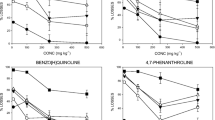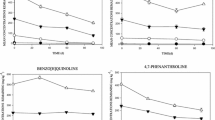Abstract
It is now acknowledged that aromatic hydrocarbons present in contaminated soils occur in mixtures. The effect of single, binary and quinary mixtures of phenanthrene and selected nitrogen-containing polycyclic aromatic hydrocarbons (N-PAHs) were investigated on the survival, growth and behavioural index of earthworms (Eisenia fetida) over a 21-day incubation in soil. The results showed that the LC50 values ranged from (not detected) ND–329.3 mg kg−1 (single mixture), ND–219.8 mg kg−1 (binary mixtures) to 148.4 mg kg−1 (quinary mixture), while the EC50 values (based on weight loss) ranged from 13.3–148.4 mg kg−1 (single mixture), 63.8–148.4 mg kg−1 (binary mixture) to 24.2 mg kg−1 (quinary mixture). Greater impacts were recorded where N-PAHs are present with phenanthrene. Further, behavioural index of E. fetida was affected after 24-h exposure to N-PAH-amended soils. Among the N-PAHs however, benzo[h]quinoline recorded the greatest impact on the survival, growth and behavioural index of E. fetida in soil. Findings from this study showed that three ring-N-PAHs are more toxic than phenanthrene as expected from their physico-chemical properties. The binary and quinary mixtures of phenanthrene and N-PAHs in soil intensified toxicity, suggesting that PAHs-N-PAHs mixtures represent greater risk to soil biota.




Similar content being viewed by others
References
Anderson, W. C., Loehr, R. C., & Smith, B. P. (1999). Environmental availability of chlorinated organics, explosives and metals in soils. Annapolis: American Academy of Environmental Engineer.
Anyanwu, I. N., & Semple, K. T. (2015a). Fate and behaviour of nitrogen-containing polycyclic aromatic hydrocarbons in soil. Environmental Technology and Innovation, 3, 108–120.
Anyanwu, I. N., & Semple, K. T. (2015b). Biodegradation of phenanthrene-nitrogen-containing analogues in soil. Water, Air, and Soil Pollution, 226, 252.
Anyanwu, I. N., & Semple, K. T. (2015c). Phytotoxicity of phenanthrene and its nitrogen polycyclic aromatic hydrocarbon analogues in ageing soil. Water, Air, and Soil Pollution, 226, 347.
Anyanwu, I. N., & Semple, K. T. (2016a). Assessment of the effects of phenanthrene and its nitrogen heterocyclic analogues on microbial activity in soil. Springerplus, 5, 279.
Anyanwu, I. N., & Semple, K. T. (2016b). Effects of phenanthrene and its nitrogen-heterocyclic analogues aged in soil on the earthworm Eisenia fetida. Applied Soil Ecology, 105, 151–159.
Anyanwu, I.N., Clifford, O.I., & Semple, K.T. (2013). Effects of three ringed PAH and N-PAHs on earthworm (E. fetida) in soil. In: Proceedings of the International Conference on Environmental Pollution and Remediation. International Academy of Science Engineering and Technology, Toronto (Ontario, Canada), pp. 57.
Bleeker, E. A. J., Wiegman, S., Kraak, M., de Voogt, P., Leslie, H. A., Haas, E., & Admiraal, W. (2002). Toxicity of azaarenes. Reviews of Environmental Contamination and Toxicology, 173, 39–83.
Brar, N. K., Waggoner, C., Reyes, J. A., Fairey, R., & Kelley, K. M. (2010). Evidence for thyroid endocrine disruption in wild fish in San Francisco Bay, California, USA. Relationships to contaminant exposures. Aquatic Toxicology, 93, 203–2015.
Broholm, M. M., Broholm, K., & Arvin, E. (1999). Sorption of heterocyclic compounds on natural clay till. Journal of Contaminant Hydrology, 39, 183–200.
Brumley, W. C., Brownrigg, C. M., & Brilis, G. M. (1991). Characterization of nitrogen-containing aromatic compounds in soil and sediment by capillary gas chromatography–mass spectrometry after fractionation. Journal of Chromatography, 558, 223–233.
De Voogt, P., & Laane, R. W. P. W. (2009). Assessment of azaarenes and azaarones (oxidized azaarene derivatives) in the Dutch coastal zone of the North Sea. Chemosphere, 76, 1067–1074.
Doick, K. J., Lee, P. H., & Semple, K. T. (2003). Assessment of spiking procedures for the introduction of phenanthrene-LNAPL mixture into field-wet soil. Environmental Pollution, 126, 399–406.
Environment Canada (2011). Risk management scope for quinoline. Chemical Abstract Service Registry Number (CAS RN), 91-22-5: http://www.ec.gc.ca/ese-ees/default.asp?lang.
Feldmannová, M., Hilscherová, K., Marsálek, B., & Bláha, L. (2006). Effects of N-heterocyclic polyaromatic hydrocarbons on survival, reproduction and biochemical parameter in Dalphnia magna. Environmental Toxicology and Chemistry, 21, 425–431.
IARC (2012). In: IARC monographs on the evaluation of carcinogenic risk of chemicals to humans. Agents classified by IARC Monographs. World Health Organization 1–105.
Kobetičová, K., Bezchlebová, J., Lána, J., Sochová, I., & Hofman, J. (2008). Toxicity of four nitrogen heterocyclic polyaromatic hydrocarbons (NPAHs) to soil organisms. Ecotoxicology and Environmental Safety, 71, 650–660.
Kobetičová, K., Šimek, Z., Brezovský, B., & Hofman, J. (2011). Toxic effects of nine polycyclic aromatic compounds on Enchytraeus crypticus in artificial soil in relation to their properties. Ecotoxicology and Environmental Safety, 74, 1727–1733.
Langdon, C. J., Piearce, T. G., Black, S., & Semple, K. T. (1999). Resistance of arsenic toxicity in a population of earthworm Lumbricus rubella. Soil Biology and Chemistry, 31, 1963–1967.
Meyer, S., & Steinhart, H. (2000). Effects of heterocyclic PAHs (N, S, O) on the biodegradation of typical tar oil PAHs in a soil/compost mixture. Chemosphere, 40, 357–367.
OECD (1984). Guideline draft 207 for the testing of chemicals. Earthworm acute toxicity tests.
Sochová, I., Hofman, J., & Holoubek, I. (2007). Effects of seven organic pollutants soil nematode Caenorhabditis elegans. Environment International, 33, 798–804.
Spurgeon, D. J., Hopkin, S. P., & Jones, D. T. (1994). Effects of cadmium, copper, lead and zinc on growth, reproduction and survival of the earthworm Eisenia fetida (savingy): assessing the environmental impact of the point-sources metal contamination in terrestrial ecosystems. Environmental Pollution, 84, 123–130.
Švábenský, R., Oravec, M., & Šimek, Z. (2009). Determination of polycyclic aromatic nitrogen heterocycles in soil using liquid chromatography/tadem mass spectrometry. International Journal of Environment and Analytical Chemistry, 89, 167–181.
Sverdrup, L. E., Krogh, P. H., Nielsen, T., & Stenersen, J. (2002). Relative sensitivity of three terrestrial invertebrate tests to polycyclic aromatic compounds. Environmental Toxicology and Chemistry, 21, 1927–1933.
Webber, M. D. (1994). Industrial organic compounds in selected Canadian municipal sludges and agricultural soils. Final report for Land Resource Division, Centre for Land and Biological Resources Research Agriculture and Agri-Food Canada (p. 100). Burlington: Environment Canada, Wastewater Technology Centre.
Widdows, J., & Donkin, P. (1989). The application of combined tissue residue chemistry and physiological measurements of mussels (Mytilus edulis) for the assessment of environmental pollution. Hydrobiologia, 188(189), 455–461.
Willumsen, P. A., Nielsen, J. K., & Karl, U. (2001). Degradation of phenanthrene-analogue azaarenes by Mycobacteium gilvum strain LB307T under aerobic conditions. Applied Microbiology and Biotechnology, 56, 539–544.
Willumsen, P. A., Johansen, J. E., Karlson, U., & Hansen, B. M. (2005). Isolation and taxonomic affiliation of N-heterocyclic aromatic hydrocarbon-transforming bacteria. Applied Microbiology and Biotechnology, 67, 420–428.
Acknowledgments
The authors are grateful to Petroleum Technology Development Fund (PTDF), Nigeria, for providing financial support.
Author information
Authors and Affiliations
Corresponding author
Rights and permissions
About this article
Cite this article
Anyanwu, I.N., Clifford, O.I. & Semple, K.T. Effects of Single, Binary and Quinary Mixtures of Phenanthrene and Its N-PAHs on Eisenia fetida in Soil. Water Air Soil Pollut 228, 105 (2017). https://doi.org/10.1007/s11270-017-3290-z
Received:
Accepted:
Published:
DOI: https://doi.org/10.1007/s11270-017-3290-z




